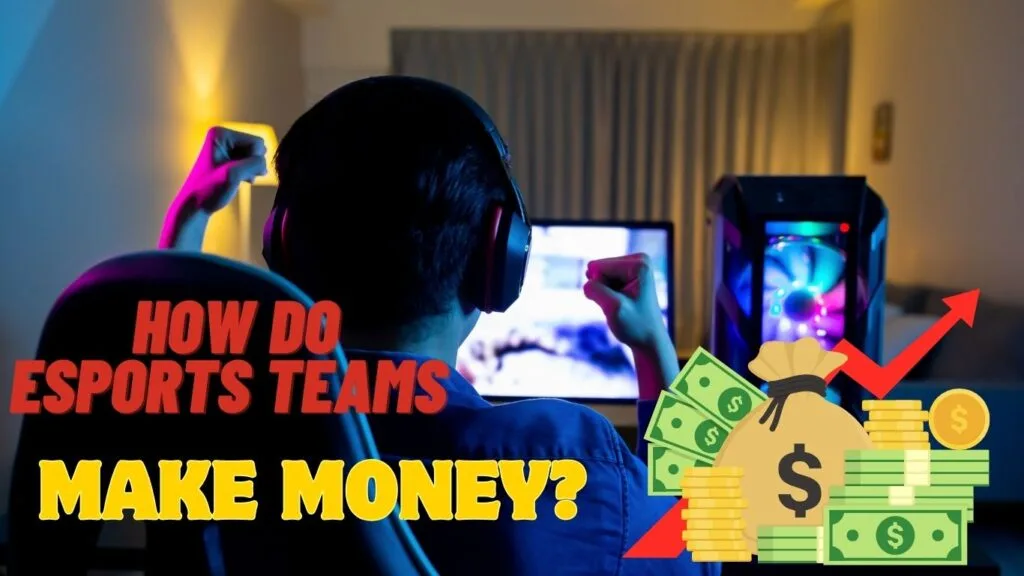
Esports, which stands for “electronic sports,” has quickly grown from a little hobby to a global industry worth billions of dollars. Esports teams today act like professional sports teams, with millions of fans, international competitions, and big sponsorships. But the question is still there: how do esports teams really make money?
In this post, we’ll look at all the main ways that esports companies make money, the business model behind competitive gaming, and what the future holds for an industry that is growing quickly.
1. An Overview of the Esports Business Model
Esports teams work in a way that is very similar to regular sports teams. They hire talented players, participate in tournaments, establish sponsorship deals, sell goods, and provide content to get fans. Esports teams, on the other hand, have their own set of problems. For example, they depend on digital platforms and game producers for exposure and chances, unlike football or cricket clubs.
Sponsorships, media rights, and fan interaction are estimated to bring in more than $4 billion in income for the esports industry by 2030. It’s important for players, investors, and fans to know where this money originates from.
2. Tournament Winnings:
The Most Obvious, but Not the Biggest Source
When people think about how esports players make money, one of the first things that comes to mind is tournament prize money. This can be a big deal for top-tier teams, but for most companies, it’s not their main source of cash.
The 2021 Dota 2 International had a prize pool of more than $40 million. Team Spirit, the winning team, got $18.2 million.
In reality, only the best teams continuously win big amounts of money; lower-ranked teams rarely make enough to stay in business.
Why it’s not reliable: You can’t count on tournament winnings.
Players, the organization, and sometimes coaches all get a share of the prize fund.
A terrible season can significantly reduce your income since it depends on your performance.
3. Sponsorships: The Most Important Source of Income
Most esports teams depend on sponsorships to stay alive. Brands work with teams to target youthful, interested audiences by putting their logos on things, running ads, and making promotional content.
How sponsorship works in esports:
Companies pay esports teams to place their logos on jerseys, stream overlays, or post on social media.
Product marketing during live streams can be part of sponsored content.
Teams often establish contracts with software businesses, energy drink brands, and gaming gear makers that last for more than one year.
For example, Team Liquid gets millions of dollars in sponsorship money from Alienware, Monster Energy, and Honda.
What makes it profitable:
Contracts often guarantee steady sponsorship money.
Brands think that esports is a direct way to reach Gen Z and Millennial audiences.
4. Selling the Team Brand through Merchandising
Merchandise is another important way for esports teams to make money, especially if they have many fans.
Types of goods sold:
Team-branded jerseys and hoodies
Mousepads, keycaps, and controller skins are some examples of gaming accessories.
Limited-edition partnerships with apparel brands
For example, 100 Thieves works like a fashion business, putting out streetwear collections that sell out in hours and make a lot of money.
Benefits of selling merchandise:Makes fans more loyal
Gives you a continuous revenue even when there aren’t any tournaments.
When fans wear team gear, it increases the team’s marketing exposure.
5. Streaming and Making Content—Digital Gold
For esports teams, streaming sites like Twitch, YouTube, and Kick are crucial sources of income.
How teams get money from streaming:
Ads on Twitch or YouTube generate revenue.
Fans give money and pay for subscriptions.
Brand bargains for streaming videos
Selling highlights to news organizations
Many esports players stream when they’re not playing, which keeps fans interested and makes money.
At his peak, Ninja, without a specific team, reportedly earned $500,000 a month from Twitch subscriptions.
6. Media Rights—Selling Access to Broadcasts
As esports events get bigger, the rights to cover them in the media become more valuable. YouTube Gaming and Twitch, for example, often pay for the ability to stream important events only on their sites.
How teams gain:
Some leagues give some of the money they make from broadcasting to the clubs that play in them.
Teams can make their own deals for behind-the-scenes or documentary-style videos.
For example, YouTube paid $160 million for the broadcast rights to the Overwatch League. Some of this money went to the teams.
7. Franchise leagues—long-term investment
Many esports games now include franchise-based leagues, like the NBA or NFL, where teams pay to get permanent spots in the league.
Advantages of franchise systems:
Guaranteed entry in tournaments
Sharing league profits with other teams
Stability for investors and sponsors
For example, it costs $25 million for each team to join the Call of Duty League, but companies make money by sharing the money they make.
8. Video game betting and partnerships
Betting partnerships are controversial, yet they make a lot of money. Companies that take bets pay for tournaments or teams to promote their websites.
Risks and rewards:
It can be profitable but dangerous because of gambling rules
In some places, betting relationships are completely illegal.
9. Working together with creators and using social media to get the word out
Esports teams often get into influencer marketing by hiring popular broadcasters and content creators, even if they don’t play competitively.
Why it works:
Creators bring many fans to the brand.
It extends beyond the realm of competitive gaming.
For example, FaZe Clan makes a lot of money by working with influencers, running YouTube channels, and promoting a certain lifestyle.
10. Future ways to make money in esports
Esports teams are likely to become even more varied in the future:
NFTs and digital collectibles are things you may buy in games and sell as virtual goods.
Metaverse Events: Putting on virtual tournaments and fan gatherings.
Training Academies: Making money by teaching and coaching esports.
11. Problems that make it challenging for esports teams to make money
Despite their potential, many esports teams still struggle to generate revenue.
Some common problems are:
High costs of doing business (player salaries, travel, gaming gear)
The outcomes of tournaments are difficult to predict.
A lot of reliance on sponsorships
Market volatility if a game stops being popular
Conclusion
Esports teams get money from various sources, including sponsorships, merchandise sales, streaming revenue, tournament winnings, and media rights. The sector is doing well, but making money depends on excellent branding, having many sources of income, and keeping fans interested.
As the esports market matures, teams that prioritize business while maintaining the competitive spirit will not only lead the leaderboards but also succeed financially
1. What is the main source of income for esports teams?
Most esports teams earn the majority of their revenue from sponsorships and brand partnerships.
2. Do esports players get paid a salary?
Yes, most professional players receive a base salary, often supplemented by prize winnings and sponsorship bonuses.
3. How much do esports teams make from tournaments?
It varies greatly. Top teams can earn millions annually, but for many organizations, tournament winnings are a small portion of their total income.
4. Can small esports teams make money?
Yes, but it’s challenging. Smaller teams often rely on local sponsorships, small tournament winnings, and streaming revenue.
5. How do esports sponsorships work?
Companies pay teams to display logos, promote products, or create branded content in exchange for exposure to gaming audiences.
6. Are esports teams profitable?
Some are, especially the biggest names, but many still operate at a loss while investing in growth.


